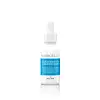What's inside
What's inside
 Key Ingredients
Key Ingredients

 Benefits
Benefits

 Concerns
Concerns

 Ingredients Side-by-side
Ingredients Side-by-side

Water
Skin ConditioningDimethicone
EmollientGlycerin
HumectantPropanediol
SolventSodium Hyaluronate
HumectantNiacinamide
SmoothingLactobacillus Ferment Lysate Filtrate
Skin ConditioningEthyl Oleate
EmollientLeuconostoc/Radish Root Ferment Filtrate
AntimicrobialPopulus Tremuloides Bark Extract
AntiseborrhoeicButyrospermum Parkii Butter Unsaponifiables
Skin ConditioningSqualane
EmollientPolyacrylate Crosspolymer-6
Emulsion Stabilising1,2-Hexanediol
Skin ConditioningHydroxyethyl Acrylate/Sodium Acryloyldimethyl Taurate Copolymer
Emulsion StabilisingEthyl Stearate
EmollientDimethiconol
EmollientSodium Gluconate
Skin ConditioningEthyl Linoleate
EmollientHydroxyacetophenone
AntioxidantCaprylyl Glycol
EmollientPolysorbate 60
EmulsifyingSorbitan Isostearate
EmulsifyingT-Butyl Alcohol
PerfumingWater, Dimethicone, Glycerin, Propanediol, Sodium Hyaluronate, Niacinamide, Lactobacillus Ferment Lysate Filtrate, Ethyl Oleate, Leuconostoc/Radish Root Ferment Filtrate, Populus Tremuloides Bark Extract, Butyrospermum Parkii Butter Unsaponifiables, Squalane, Polyacrylate Crosspolymer-6, 1,2-Hexanediol, Hydroxyethyl Acrylate/Sodium Acryloyldimethyl Taurate Copolymer, Ethyl Stearate, Dimethiconol, Sodium Gluconate, Ethyl Linoleate, Hydroxyacetophenone, Caprylyl Glycol, Polysorbate 60, Sorbitan Isostearate, T-Butyl Alcohol
Water
Skin ConditioningGlycerin
HumectantSodium Lauroyl Lactylate
EmulsifyingSodium Hyaluronate
HumectantPolysorbate 20
EmulsifyingCaprylic/Capric Triglyceride
MaskingPEG/PPG-14/4 Dimethicone
EmulsifyingXanthan Gum
EmulsifyingDisodium EDTA
Sodium Cocoyl Amino Acids
CleansingCeramide NP
Skin ConditioningEthylhexylglycerin
Skin ConditioningEpilobium Angustifolium Extract
Skin ConditioningCeramide AP
Skin ConditioningCholesterol
EmollientPhytosphingosine
Skin ConditioningBeta-Glucan
Skin ConditioningSarcosine
Skin ConditioningCarbomer
Emulsion StabilisingChrysanthemum Parthenium Flower Extract
Skin ConditioningSea Whip Extract
Skin ConditioningGlycine Soja Seed Extract
Skin ConditioningHyaluronic Acid
HumectantGlycyrrhiza Glabra Root Extract
BleachingCeramide EOP
Skin ConditioningMagnesium Aspartate
Skin ConditioningPotassium Aspartate
Skin ConditioningUbiquinone
AntioxidantPhenoxyethanol
Preservative1,2-Hexanediol
Skin ConditioningCaprylyl Glycol
EmollientLeuconostoc/Radish Root Ferment Filtrate
AntimicrobialCalcium Chloride
AstringentPropylene Glycol
HumectantTocopherol
AntioxidantSodium Metabisulfite
AntioxidantPentaerythrityl Tetra-Di-T-Butyl Hydroxyhydrocinnamate
AntioxidantSodium Benzoate
MaskingPotassium Sorbate
PreservativeWater, Glycerin, Sodium Lauroyl Lactylate, Sodium Hyaluronate, Polysorbate 20, Caprylic/Capric Triglyceride, PEG/PPG-14/4 Dimethicone, Xanthan Gum, Disodium EDTA, Sodium Cocoyl Amino Acids, Ceramide NP, Ethylhexylglycerin, Epilobium Angustifolium Extract, Ceramide AP, Cholesterol, Phytosphingosine, Beta-Glucan, Sarcosine, Carbomer, Chrysanthemum Parthenium Flower Extract, Sea Whip Extract, Glycine Soja Seed Extract, Hyaluronic Acid, Glycyrrhiza Glabra Root Extract, Ceramide EOP, Magnesium Aspartate, Potassium Aspartate, Ubiquinone, Phenoxyethanol, 1,2-Hexanediol, Caprylyl Glycol, Leuconostoc/Radish Root Ferment Filtrate, Calcium Chloride, Propylene Glycol, Tocopherol, Sodium Metabisulfite, Pentaerythrityl Tetra-Di-T-Butyl Hydroxyhydrocinnamate, Sodium Benzoate, Potassium Sorbate
 Reviews
Reviews

Ingredients Explained
These ingredients are found in both products.
Ingredients higher up in an ingredient list are typically present in a larger amount.
1,2-Hexanediol is a synthetic liquid and another multi-functional powerhouse.
It is a:
- Humectant, drawing moisture into the skin
- Emollient, helping to soften skin
- Solvent, dispersing and stabilizing formulas
- Preservative booster, enhancing the antimicrobial activity of other preservatives
Caprylyl Glycol is a humectant and emollient, meaning it attracts and preserves moisture.
It is a common ingredient in many products, especially those designed to hydrate skin. The primary benefits are retaining moisture, skin softening, and promoting a healthy skin barrier.
Though Caprylyl Glycol is an alcohol derived from fatty acids, it is not the kind that can dry out skin.
This ingredient is also used as a preservative to extend the life of products. It has slight antimicrobial properties.
Learn more about Caprylyl GlycolGlycerin is already naturally found in your skin. It helps moisturize and protect your skin.
A study from 2016 found glycerin to be more effective as a humectant than AHAs and hyaluronic acid.
As a humectant, it helps the skin stay hydrated by pulling moisture to your skin. The low molecular weight of glycerin allows it to pull moisture into the deeper layers of your skin.
Hydrated skin improves your skin barrier; Your skin barrier helps protect against irritants and bacteria.
Glycerin has also been found to have antimicrobial and antiviral properties. Due to these properties, glycerin is often used in wound and burn treatments.
In cosmetics, glycerin is usually derived from plants such as soybean or palm. However, it can also be sourced from animals, such as tallow or animal fat.
This ingredient is organic, colorless, odorless, and non-toxic.
Glycerin is the name for this ingredient in American English. British English uses Glycerol/Glycerine.
Learn more about GlycerinLeuconostoc/Radish Root Ferment Filtrate is a natural preservative. It comes from fermenting radish roots with a bacteria called leuconostoc.
Leuconostoc comes from lactic acid.
This ingredient has antimicrobial properties and helps prevent the growth of bacteria in a product.
Leuconostoc is used to make the traditional Korean side-dish, kimchi. It is also used to make sourdough bread (both incredibly yummy foods).
Learn more about Leuconostoc/Radish Root Ferment FiltrateSodium Hyaluronate is hyaluronic acid's salt form. It is commonly derived from the sodium salt of hyaluronic acid.
Like hyaluronic acid, it is great at holding water and acts as a humectant. This makes it a great skin hydrating ingredient.
Sodium Hyaluronate is naturally occurring in our bodies and is mostly found in eye fluid and joints.
These are some other common types of Hyaluronic Acid:
Learn more about Sodium HyaluronateWater. It's the most common cosmetic ingredient of all. You'll usually see it at the top of ingredient lists, meaning that it makes up the largest part of the product.
So why is it so popular? Water most often acts as a solvent - this means that it helps dissolve other ingredients into the formulation.
You'll also recognize water as that liquid we all need to stay alive. If you see this, drink a glass of water. Stay hydrated!
Learn more about Water